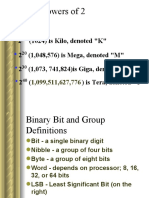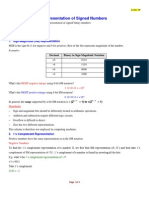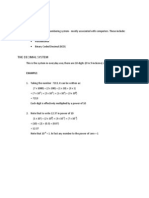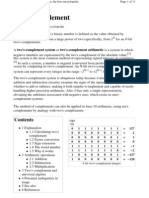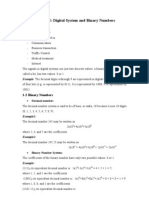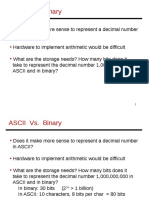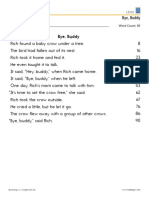Twos Comp
Twos Comp
Uploaded by
dj14aCopyright:
Available Formats
Twos Comp
Twos Comp
Uploaded by
dj14aOriginal Title
Copyright
Available Formats
Share this document
Did you find this document useful?
Is this content inappropriate?
Copyright:
Available Formats
Twos Comp
Twos Comp
Uploaded by
dj14aCopyright:
Available Formats
CSU200 Discrete Structures Fall 2005
Profs. Aslam & Fell October 27, 2005
Representing Negative Numbers: Twos Complement
In class we have discussed binary representations of the non-negative integers {0, 1, 2, . . .}. However, one must often deal with negative numbers; how can they be represented as well? One obvious solution would be to use a single bit to represent the sign of the number (+ or ) and the remaining bits to represent the magnitude of the number (how positive or negative it is). In such a signed magnitude representation, a most-signicant bit of 0 represents + while a most-signicant bit of 1 represents ; the remaining bits give the magnitude of the number. For example, an 8-bit signed magnitude representation of 13 is 00001101 while 13 is 10001101. Note that using 8-bit signed magnitude, one can represent integers in the range 127 (11111111) to 127 (01111111). Signed magnitude has one peculiarity, however. The integer 0 can be represented in two ways: 00000000 = +0 and 10000000 = 0. By far, the most common representation of positive and negative integers is twos complement. In twos complement, positive integers are represented in standard binary, as in signed magnitude. However, the representation of a negative number is determined as follows: (1) compute a binary representation of the magnitude of the number, (2) ip all the bits, and (3) add 1. For example, the 8-bit twos complement representation of 13 is 00001101 (as before) while 13 is represented as follows (using the steps given above): 13 = 00001101 = 11110010 = 11110011 Note that a most-signicant bit of 1 again signies a negative number, but the remaining bits do not encode the magnitude in the usual way. Here are a few more examples of converting integers to 8-bit twos complement form (remember that non-negative integers are represented in standard binary): 15 15 28 28 =
(1) (1) (2) (3)
00001111
(2) (3)
= =
(1)
00001111 00011100
11110000
11110001
(2)
(3)
00011100
11100011
11100100
To convert a negative twos complement number back to decimal, follow these steps: (1) ip all the bits, (2) add 1, and (3) interpret the result as a binary representation of the magnitude and add a negative sign. For example, 11110011 = 00001100 = 00001101 = 13 Here are a few more examples of converting 8-bit twos complement back to decimal (remember that if the number begins with a 0, its a non-negative integer represented in standard binary):
(1) (2) (3)
00010110 10010110 01001001 11001001
=
(1)
22
(2) (3)
= =
(1)
01101001 73
01101010
106
(2)
(3)
00110110
00110111
55
Using 8-bit twos complement, one can represent integers in the range 128 (10000000) to 127 (01111111), and 0 is represented in only one way (00000000). Finally, the real utility and power of twos complement is that one can add pairs of twos complement numbers (whether positive or negative) in the usual way, and the result will be the correct answer, in twos complement! In the following examples, superscripts in the binary addition represent carries. + 13 15 28 + 0 0 0 0 0 0 0 0 0 01 0 1 11 1 1 11 1 1 01 1 0 1 1 0
Note that this is just standard binary addition. Now, however, lets consider subtracting 15 from 28; this is equivalent to adding 15 to 28. 28 15 13 + 28 15 13 + 01 1 0 01 1 0 01 1 0 1 1 0 1 0 1 1 0 1 0 0 0 0 1 1
Note that we ignore the carry out of the last column.1 Now consider subtracting 28 from 15. 15 28 13 + 15 28 13 + 0 1 1 0 1 1 0 1 1 01 0 1 11 0 0 1 1 0 1 0 1 1 0 1
Note that the answer obtained is the proper twos complement representation of 13. Finally, consider adding 13 and 15. + 13 15 28 + 11 1 1 11 1 1 11 1 1 1 1 0 0 0 0 01 0 1 11 0 0 1 1 0
Note that we again ignore the carry out of the last column, and we obtain the proper twos complement representation of 28. More examples of twos complement may be found at: http://en.wikipedia.org/wiki/Twos_complement
In general, carries into or out of the most signicant bit must be carefully considered as this may result from an overow condition, i.e., obtaining a result which is too large (> 127) or too small (< 128) to be represented in 8-bit twos complement. In this brief note, however, we assume that all results can be properly represented in 8-bit twos complement.
You might also like
- A Dictionary of Jewish Babylonian AramaicDocument26 pagesA Dictionary of Jewish Babylonian Aramaicsedra12No ratings yet
- Humor in The BibleDocument7 pagesHumor in The BibleAlexandre GonçalvesNo ratings yet
- CH 2Document25 pagesCH 2eyobeshete01No ratings yet
- Lec9 Fixed Point RepresentationDocument19 pagesLec9 Fixed Point RepresentationRaman KalraNo ratings yet
- COA Chapter 2Document15 pagesCOA Chapter 2Chala GetaNo ratings yet
- Week 2 - Number System Numeric Complements PDFDocument9 pagesWeek 2 - Number System Numeric Complements PDFjennyNo ratings yet
- Two's Complement: To Translate A Number in Binary Back To Base Ten, The Steps Are Reversed: 1110 1111 1 1110 1110Document3 pagesTwo's Complement: To Translate A Number in Binary Back To Base Ten, The Steps Are Reversed: 1110 1111 1 1110 1110Roshan RajuNo ratings yet
- Negative Number RepresentationDocument4 pagesNegative Number Representationtadele766No ratings yet
- Calculation of 2's Complement Addition Subtraction Multiplication Division Sign Extension Other Signed Representations NotesDocument6 pagesCalculation of 2's Complement Addition Subtraction Multiplication Division Sign Extension Other Signed Representations Notesjohn paulNo ratings yet
- CH 8 StallingsDocument38 pagesCH 8 StallingsRifah TasniaNo ratings yet
- Special Powers of 2Document47 pagesSpecial Powers of 2Ana HassanNo ratings yet
- Computer OrganaizationDocument28 pagesComputer OrganaizationHaile BelayNo ratings yet
- Number Systems, Operations, and CodesDocument50 pagesNumber Systems, Operations, and CodesManqoba Muntu MasukuNo ratings yet
- Representation of Signed Numbers: 1. Sign-Magnitude (SM) RepresentationDocument4 pagesRepresentation of Signed Numbers: 1. Sign-Magnitude (SM) RepresentationAamna MaqsoodNo ratings yet
- Lecture 2 SlidesDocument22 pagesLecture 2 Slides2020n0800No ratings yet
- CH 2 Pink FloydDocument46 pagesCH 2 Pink FloydAbdullah AftabNo ratings yet
- Lect 3Document58 pagesLect 3gupta.pagNo ratings yet
- Chapter 3 - Base NumberDocument13 pagesChapter 3 - Base NumberZufayri Peyi100% (1)
- Ch01P3 Integer RepresentationDocument42 pagesCh01P3 Integer Representationخالد الروميNo ratings yet
- Signed Integer RepresentationDocument3 pagesSigned Integer RepresentationemanresusugobNo ratings yet
- Lecture 1Document28 pagesLecture 1kmohey101No ratings yet
- Binary RepresentationDocument10 pagesBinary Representationkerrykay100% (1)
- Lecture #3Document17 pagesLecture #3Nahom BiniyamNo ratings yet
- CH 8 StallingsDocument38 pagesCH 8 StallingsRifah TasniaNo ratings yet
- Computer Architecture Number RepresentationsDocument74 pagesComputer Architecture Number RepresentationsLuciusNo ratings yet
- Signed Number RepresentationsDocument18 pagesSigned Number Representationsselvam_08No ratings yet
- Chapter II - Information Representation ING INFO-ADocument33 pagesChapter II - Information Representation ING INFO-Aadjm2024No ratings yet
- Introduction To Digital Systems EditedDocument13 pagesIntroduction To Digital Systems EditedRisper AudiNo ratings yet
- Number SystemDocument45 pagesNumber Systemhrishipisal0% (1)
- Ceng252 Lecture1Document8 pagesCeng252 Lecture1smadi13No ratings yet
- Wiki Twos ComplementDocument11 pagesWiki Twos ComplementmaterkyNo ratings yet
- CO Notes (Arithematic Operations)Document6 pagesCO Notes (Arithematic Operations)Anupama MishraNo ratings yet
- Binary AdditionDocument3 pagesBinary Additionhammad646No ratings yet
- 0 NotesDocument3 pages0 NotesMohammed AliNo ratings yet
- "Twos Complement" Representation of IntegersDocument7 pages"Twos Complement" Representation of IntegersUsNo ratings yet
- Number Representation: CHAPTER 3 - Part 3Document52 pagesNumber Representation: CHAPTER 3 - Part 3rqwrqwrNo ratings yet
- Computer Arithmetic in Computer Organization and ArchitectureDocument41 pagesComputer Arithmetic in Computer Organization and ArchitectureEswin Angel100% (1)
- Two's ComplementDocument11 pagesTwo's ComplementjunaidrdrNo ratings yet
- Lecture 1b - Number System - 0Document56 pagesLecture 1b - Number System - 0Mohammad FaizNo ratings yet
- Digital Number SystemDocument44 pagesDigital Number SystemNicholas SaweNo ratings yet
- Unit 05Document27 pagesUnit 05anjalluitel3No ratings yet
- 1.data Representation A LevelDocument128 pages1.data Representation A LevelTanatswaNo ratings yet
- Lecture #3Document13 pagesLecture #3Abdii MakNo ratings yet
- Computer Architecture and Organization Chapter 2Document17 pagesComputer Architecture and Organization Chapter 2አኖኒ መስNo ratings yet
- Slide03 NumSys Ops Part1Document47 pagesSlide03 NumSys Ops Part1อภิเษก หงษ์วิทยากรNo ratings yet
- Chapter I Digital SystemsDocument8 pagesChapter I Digital SystemsShubham SinghNo ratings yet
- ASCII vs. BinaryDocument15 pagesASCII vs. BinaryArun JainNo ratings yet
- Chapter 1: Digital Systems and Binary NumbersDocument48 pagesChapter 1: Digital Systems and Binary NumbersKeerthana MNo ratings yet
- Number System ReviewerDocument5 pagesNumber System ReviewerGerthie EspañolaNo ratings yet
- Cs2100 9 Floating PointDocument32 pagesCs2100 9 Floating PointamandaNo ratings yet
- Computer Organization and Assembly Language: Lecture 5 & 6 Computer Arithmetic Integer Representation, Integer ArithmeticDocument29 pagesComputer Organization and Assembly Language: Lecture 5 & 6 Computer Arithmetic Integer Representation, Integer ArithmeticDarwin VargasNo ratings yet
- Lecture - 6 - Binary System Operations and Representation of Negative NumbersDocument6 pagesLecture - 6 - Binary System Operations and Representation of Negative Numbersnonow81165No ratings yet
- Arithmetic Op CompEng 110903Document78 pagesArithmetic Op CompEng 110903BALAMU MBUZWENo ratings yet
- CENG 365 Microprocessor UENR Unit 2Document56 pagesCENG 365 Microprocessor UENR Unit 2Albert DekuNo ratings yet
- Two's Complement: Three-Bit Signed IntegersDocument12 pagesTwo's Complement: Three-Bit Signed Integersmadhav singhNo ratings yet
- Coa Chapter 1Document62 pagesCoa Chapter 1mulugetahiluf995No ratings yet
- 10 Data Representation 31 Jul 2018 Reference Material I Data Representation1Document32 pages10 Data Representation 31 Jul 2018 Reference Material I Data Representation1Om PrakashNo ratings yet
- Data RepresentationDocument14 pagesData RepresentationNicole Jhay PandaraoanNo ratings yet
- CS2Document15 pagesCS2akshat1apsNo ratings yet
- Lecture 9 Numbering Systems 4Document19 pagesLecture 9 Numbering Systems 4nadalshahedNo ratings yet
- 3-MS Examples PDFDocument59 pages3-MS Examples PDFlexuanminhk54lochoaNo ratings yet
- Sounds & Spelling of Irish/Fuaimeanna Agus Litriú Na GaeilgeDocument4 pagesSounds & Spelling of Irish/Fuaimeanna Agus Litriú Na GaeilgeJoy L AndersonNo ratings yet
- Lesson 2Document7 pagesLesson 2CharityOriaNo ratings yet
- CELTA Assignment 1Document5 pagesCELTA Assignment 1magnolia_moog100% (2)
- Ch. 5 Determinants: Ring Determinant Functions Existence, Uniqueness and PropertiesDocument22 pagesCh. 5 Determinants: Ring Determinant Functions Existence, Uniqueness and PropertiesMas GundNo ratings yet
- Causes of The Decline of The Mughal EmpireDocument4 pagesCauses of The Decline of The Mughal EmpireZain Kolachi57% (7)
- FS 1 Episodes 1 10Document66 pagesFS 1 Episodes 1 10rosela fainaNo ratings yet
- Cabilete - Reflections On Structuralism and Post Structuralism PDFDocument5 pagesCabilete - Reflections On Structuralism and Post Structuralism PDFBhon Glory Jayn CabileteNo ratings yet
- Alcatel-Lucent B12 BSS OverviewDocument456 pagesAlcatel-Lucent B12 BSS OverviewAudreii GudieNo ratings yet
- A-Z Chinese HerbDocument7 pagesA-Z Chinese HerbswaggerboxNo ratings yet
- The Decline of The Cow: Agricultural and Settlement Change in Early Medieval IrelandDocument16 pagesThe Decline of The Cow: Agricultural and Settlement Change in Early Medieval IrelandoldenglishblogNo ratings yet
- (Francophone Postcolonial Studies) Martin Munro, Celia Britton-American Creoles - The Francophone Caribbean and The American South-Liverpool University Press (2012)Document265 pages(Francophone Postcolonial Studies) Martin Munro, Celia Britton-American Creoles - The Francophone Caribbean and The American South-Liverpool University Press (2012)matfilhoNo ratings yet
- Salient Features of Modern LinguisticsDocument5 pagesSalient Features of Modern LinguisticsAbdul Samad100% (1)
- Chapter 3 - SampleDocument9 pagesChapter 3 - SampleHanah NavaltaNo ratings yet
- Fluency TR F J Bye BuddyDocument2 pagesFluency TR F J Bye Buddyapi-474499331No ratings yet
- Content and Pedagogy PPT 221002124246 61e1cc30Document37 pagesContent and Pedagogy PPT 221002124246 61e1cc30Gladys GaleraNo ratings yet
- 8 - M (Physical) 8 - M: Period PeriodDocument1 page8 - M (Physical) 8 - M: Period Periodhafsa khalidNo ratings yet
- CGP KS2 History WorksheetsDocument5 pagesCGP KS2 History WorksheetsmisbahNo ratings yet
- Present Simple PDFDocument4 pagesPresent Simple PDFtrajano23210% (2)
- The Art of Perception Management in Information Warfare TodayDocument8 pagesThe Art of Perception Management in Information Warfare TodaySudheer KumarNo ratings yet
- Peptic Ulcer DiseaseDocument2 pagesPeptic Ulcer DiseaseMichala100% (1)
- SHUBANAN GANGAL & His Works Genius Marathi Software CreatorDocument7 pagesSHUBANAN GANGAL & His Works Genius Marathi Software CreatorVividh PawaskarNo ratings yet
- Shakespare ComedyDocument34 pagesShakespare ComedySamuel DavisNo ratings yet
- Quality-Access To SuccessDocument131 pagesQuality-Access To SuccessAdelaNo ratings yet
- Senior Assistant 5th Level AdministrationDocument9 pagesSenior Assistant 5th Level AdministrationArjun kumar ShresthaNo ratings yet
- SO3 - C1-C2 - Progress Test - 1CDocument21 pagesSO3 - C1-C2 - Progress Test - 1CVika ZhyliukNo ratings yet
- 5 Marks of An Excellent Catholic TeacherDocument1 page5 Marks of An Excellent Catholic Teacherapi-513938822No ratings yet
- Caraveo 2007Document8 pagesCaraveo 2007Karla SuárezNo ratings yet










